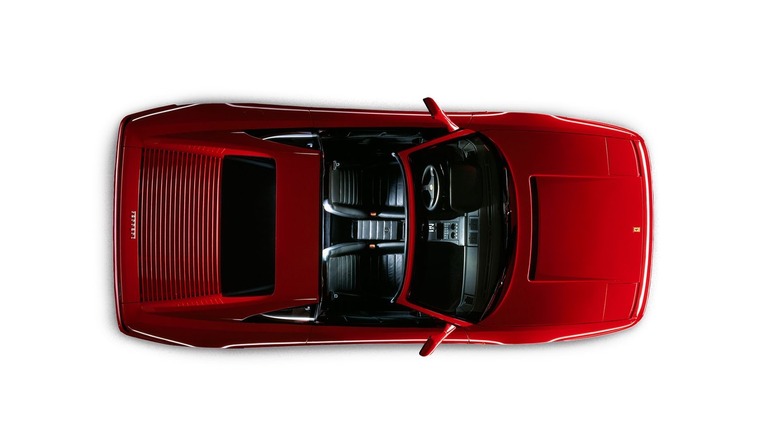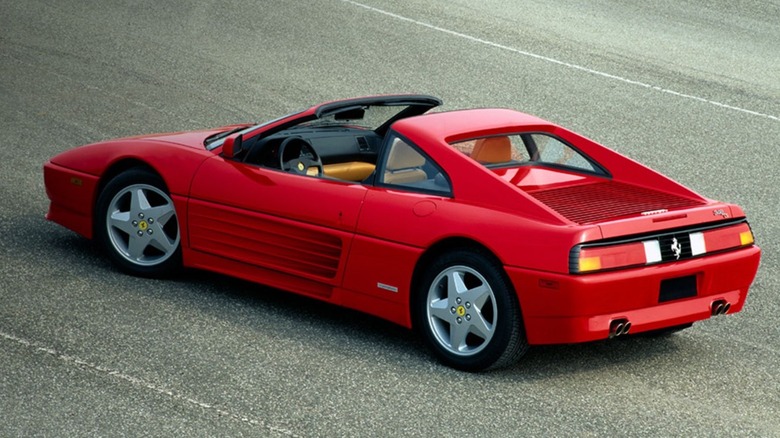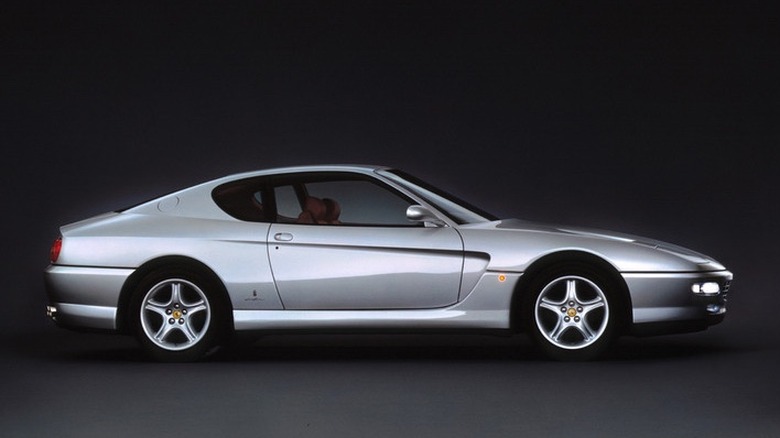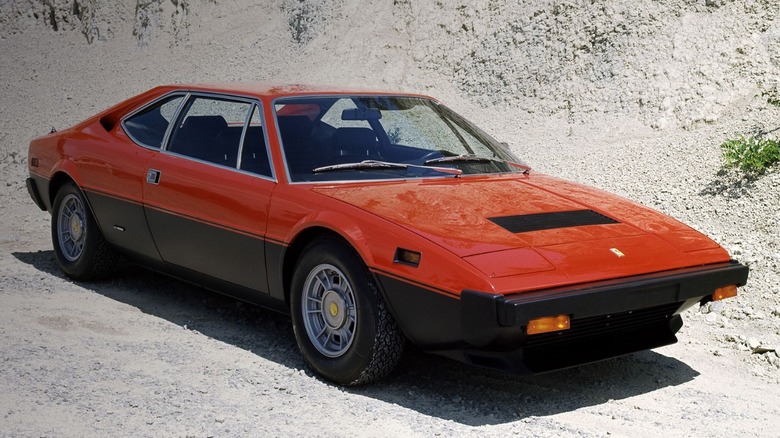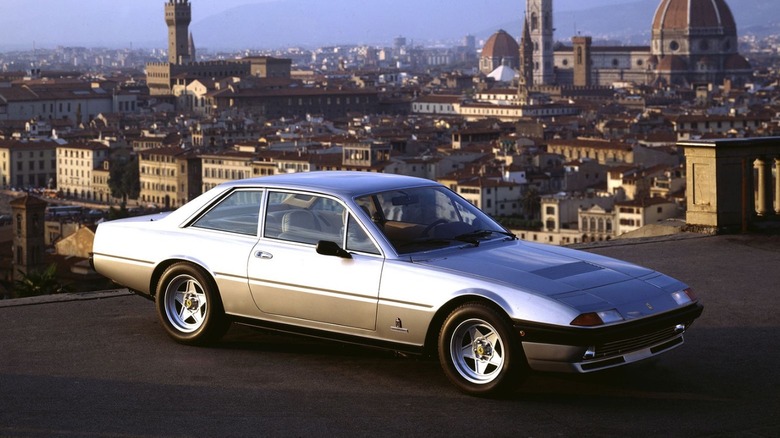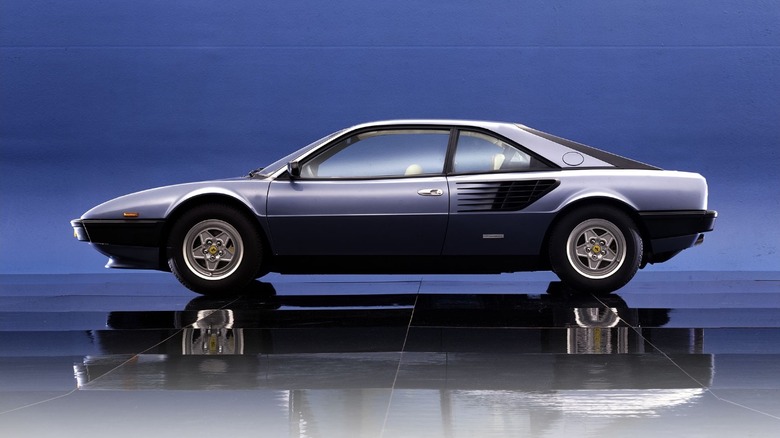Which Are The Cheapest Ferrari Models You Can Get Used?
Most people don't think of a Ferrari as a budget purchase. After all, the truly coveted models are some of the most expensive cars ever sold at auction. Right now, the cheapest Ferrari that you can buy new is the Roma, which can be considered a steal at $225,000. While some collectors might view that as chump change, the Roma is still way out of an average Joe's budget. That's where used Ferraris enter the picture.
Even then it can be tricky, as certain classic and historically significant used Ferraris can go for far more than even the most expensive new ones. For example, a 1962 Ferrari 250 GTO recently sold at auction for $38.1 million, a private island more than a new SF90 Spider. While vintage Ferraris follow that trend more often than not, there are a few examples of used models that have fallen out of favor in the pre-owned marketplace. Most of the time it isn't because the cars are bad but because the bar has been set so high that Ferrari occasionally has trouble staying out of its own shadow.
Ferrari 348 TS
The Ferrari 348 followed up some of the most sought-after cars that the brand has ever offered. When it was introduced in 1989, it replaced the outgoing Ferrari 308/328 line, which was a huge hit for the prancing horse. It also borrowed some visual cues from the iconic Testarossa, with loud, door-mounted slats that truly epitomized 1980's Ferrari styling. Unlike the V12 flagship models of the time, the 348 TS featured a 3.4 liter (34) V8 (8) that was mounted transversely (T) in its mid-mounted engine compartment behind its retractable spider roof (S) — put all of those together and its model name makes sense.
At its release, the 348 TS was a relative bargain with an MSRP of around $95,000 in 1989 compared to the $181,000 Testarossa. It didn't have that screaming V12 that Ferrari was famous for under the hood either, which made it less of an icon when it was released. To make matters worse, it was absolutely embarrassed by the then-new first-generation Acura NSX in all of the major automotive publications of the time, sullying its reputation to the point where it never recovered. Ferrari cleared its name with the F355 in 1995, but by then the 348 was already buried.
Unfortunately, that legacy remains to this day, as the 348 TS is still often looked down upon as being a bridge gap between two great Ferrari models. Its auction prices reflect that sentiment, as it's possible to pick up a low-mileage 348 TS for between $55,000 and $65,000 today.
Ferrari 456M GTA
While Ferrari is known for its race cars for the road, it is also known for crafting some of the finest grand touring cars ever built. Some greatest hits include the 365 GTB/4 Daytona, 250 GT Coupe, and, more recently, the GTC4 Lusso. However, there is one from the mid-90s that has largely slipped through the cracks — not necessarily because it was a bad car, either. The Ferrari 456 was one of the first cars launched under the oversight of Luca di Montezemolo, who is often cited as a primary figure in bringing Ferrari back from financial ruin. The 456 was the reintroduction into 2+2 grand tourers that Ferrari needed to kickstart the 1990s.
Despite being a front-engined four-seater, the 456 had the performance chops to go-toe to-toe with the best in the world. The 456 used an all-new 65-degree V12 that pumped out 436 hp. That V12 gave the 456 supercar-like acceleration and top speed, launching from 0-60 mph in 4.8 seconds and on to a top speed of 192 mph, despite being a 3,912-pound grand tourer. It was so quick, in fact, that it was the second-fastest four-seater in the world at the time, trailing only the legendary Porsche 959.
The 456 received an upgrade kit in 1999, known as the M-package, which updated the car's styling, improved aerodynamics, altered suspension characteristics, and adjusted electronic assists. The Ferrari 456M was offered with either a six-speed manual transmission or with a four-speed torque converter automatic, with the latter receiving the 'GTA' designation. While the 456M GTA was unquestionably quick, the sluggish four-speed dulled the overall experience, making it less desirable. As a result, you can pick up a used one for between $55,000 and $65,000 today.
Ferrari Dino 308 GT4
The Ferrari Dino 308 GT4 gets a bad rap in the Ferrari community. The main argument is that it isn't technically a Ferrari. There's a half-truth to that. Enzo Ferrari is famously quoted as saying, "a Ferrari is a 12-cylinder car," making the V8-engined 308 GT4 something else. While that sentiment changed a few years later with the introduction of the 308 GTB in 1975, the non-V12 powered products that came out of Ferrari's Maranello factory were branded as Dino. The Dino 308 GT4, as it was called at launch, was the final Dino offering which followed earlier six-cylinder 206 GT and 246 GT/GTS models.
The 308 GT4's styling was contentious from its introduction in 1973. Since 1951, Pininfarina has been Maranello's go-to design house, providing some of the most iconic Italian silhouettes ever to grace pavement. However, Bertone, an equally legendary design firm, was brought in for the 308 GT4 which dramatically altered the design of the car compared to Ferrari's other models. As a result, the 308 GT4 took more influence from other sharp Bertone models like the Lamborghini Countach and Urraco than it did from the coke-bottle-shaped 206 GT. Not everyone was a fan.
Despite the appearance, the 308 GT4 was liked. Its flat-plane crank 2.9L V8 was derived from the 4.4L "Colombo" V12 used in the 365 GTB/4 and made 240 hp and did zero to 62 mph in under seven seconds. Despite the 308 GT4's Ferrari-equalling performance, its ultimate sin is that it didn't quite look like one. Though it sold well initially, the 308 GT4 never caught on as a classic in the modern age. As a result, you can pick one up for around $50,000 today.
Ferrari 400 automatic i
The 400 automatic i is another example of Ferrari exercising its grand touring pedigree with to underwhelming effect. The 400 was a follow-on to the 365 GT4 2+2 introduced in 1972 as daily-driver Ferrari. It was an uprated version of the earlier model, arriving in Italian showrooms in 1976 with a carbureted 4.8L V12 under the hood. The 365 GT4 2+2 and 400 were both penned by legendary Pininfarina designer Leonardo Fioravanti responsible for some of Ferrari's most legendary models including the Ferrari Daytona and 288 GTO. Despite having an experienced hand at the drawing board, the 365 GT4 2+2 and 400 lacked the visual abrasiveness of some of Fioravanti's other designs and hinged on being a bit too pedestrian for some enthusiasts' taste.
The 400 was also notable for a not-so-fun reason. It was the first Ferrari to use an automatic transmission, which didn't help its case from a purist standpoint. Interestingly, the automatic transmission used in the 400 automatic i was a revised three-speed Turbo-Hydramatic unit supplied by General Motors, similar in design to the ones used in the Buick LeSabre at the time. In 1979, Ferrari unveiled a revised version of the 400, the 400i, which was a trendsetter in its own right. It was the first Ferrari to feature fuel injection, despite competitors using fuel injection for years at that point. Even with the new injection technology, the 400i lost 30 hp compared to its carbureted 400 GT predecessor. Needless to say, the 400i wasn't built for setting lap records. Its overall un-Ferrari-ness is likely why it's possible to pick one up for between $40,000 and $50,000 today.
Ferrari Mondial 8
In the minds of many, a Ferrari is a flash of red traveling at near-mach speeds with the athleticism to euthanize any and all competition. The Ferrari Mondial certainly wasn't that, and it wasn't supposed to be. You can think of the Ferrari Mondial 8 as somewhat of an extension of the 308 GT4, as it was its immediate successor. The Mondial 8 was released in 1980 and ditched the Dino badges in favor of prancing horses. The Mondial employed the same 2.9L Dino V8 found in the 308 GT4 but with the addition of Bosch K Jetronic fuel injection, as found on the 400i. Like with the 400i, the Mondial 8 actually lost horsepower compared to the 308 GT4, down to a lethargic 211 hp.
The Mondial was never designed to be the fastest, most agile, or most exclusive. It was designed to be solidly built, fun to drive, and easy to sell. The Mondial was the first Ferrari to be created entirely under Fiat's leadership, despite them buying Ferrari a decade prior, and it was the first Ferrari to wear Fiat's influence on its sleeve. As a result, the Mondial was designed to be more user-friendly with larger rear seats, easier diagnostic systems, and functioning A/C. Despite being a toned-down version of higher-tier models, the Mondial's underlying character was undeniably still Enzo-approved, with MotorSport magazine saying that "the Ferrari Mondial 8 is truly a Ferrari for all reasons" in their review of the car. Despite countless "the Mondial isn't as bad as people think" articles circulating nowadays, the Mondial has represented the worst that Ferrari has to offer for so long in the minds of most that their values have remained around $35,000-$45,000 for years.
